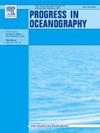西北太平洋高分辨率区域海洋再分析 K-ORA22 评估
IF 3.8
3区 地球科学
Q1 OCEANOGRAPHY
引用次数: 0
摘要
韩国海洋科学技术院开发了韩国海洋环境业务化系统-海洋可预测性实验(KOOS-OPEM),这是一种针对西北太平洋的高分辨率(1/24°,51 垂直层)海洋预报模式,采用了集合最优插值法。在本研究中,我们介绍了 KOOS-OPEM 重新分析 2022 版(K-ORA22),该版本涵盖 2011 年至 2022 年。我们对 K-ORA22 和其他高分辨率(1/10°-1/12°)全球再分析(包括混合坐标海洋模式、全球海洋再分析与模拟(GLORYS)和蓝链再分析(BRAN))进行了对比分析,以证明区域特征的再现性和可靠性。统计比较显示,虽然 K-ORA22 显示出一些暖偏差,但在去除季节周期后,其海表温度(SST)异常相关性约为 0.87,与其他再分析结果相当。此外,K-ORA22 有效地再现了沿岸上升流,即东海/日本海西南部海洋气象浮标观测到的以 SST 急剧下降为特征的上升流。K-ORA22 在 200 米附近表现出约 0.50℃的暖偏差,略高于 GLORYS 和 BRAN 的暖偏差,同时保持了次表层的低盐度偏差。值得注意的是,K-ORA22 在准确再现北太平洋和东海中间水域以盐度最低层为特征的独特特性方面优于其他再分析。此外,K-ORA22 在准确再现黄海冷水团方面表现突出,其在黄海(YS)地区的低温均方根误差(RMSE)仅为 0.76 ℃。然而,它在黄海地区和韩国/对马海峡的盐度均方根误差最大,表明可能高估了韩国和中国的河流排放量。虽然由于所使用的背景误差协方差的限制,K-ORA22 在整个区域的海面高度(SSH)异常相关性没有超过 0.80,但其再现黑潮路径的能力与其他再分析数据集相当。总之,K-ORA22 在再现韩国边缘海的独特特征方面表现出色。不过,与其他全球再分析相比,K-ORA22 仍有不足之处,如高估了河流排水量,模拟 SSH 变率的能力有限。我们计划通过更新背景误差协方差、解决与河流排水量有关的偏差以及吸收现有的最佳现场观测数据和卫星数据来改进 K-ORA22。本文章由计算机程序翻译,如有差异,请以英文原文为准。
Assessment of high-resolution regional ocean reanalysis K-ORA22 for the Northwest Pacific
The Korea Institute of Ocean Science and Technology developed the Korea Operational Oceanographic System-Ocean Predictability Experiment for Marine Environment (KOOS-OPEM), a high-resolution (1/24°, 51 vertical levels) ocean prediction model for the Northwest Pacific Ocean that incorporates ensemble optimal interpolation. In this study, we present KOOS-OPEM ReAnalysis version 2022 (K-ORA22), which covers the period from 2011 to 2022. We conducted a comparative analysis between K-ORA22 and other high-resolution (1/10°–1/12°) global reanalyses, including the Hybrid Coordinate Ocean Model, Global Ocean Reanalysis and Simulation (GLORYS), and Bluelink ReAnalysis (BRAN), to demonstrate the reproducibility and reliability of regional characteristics. Statistical comparisons revealed that while K-ORA22 exhibited some warm biases, its sea surface temperature (SST) anomaly correlation after removing the seasonal cycle was approximately 0.87, comparable to other reanalyses. Additionally, K-ORA22 effectively reproduced coastal upwelling, which is characterized by a sharp decrease in SST, as observed by marine meteorological buoys in the Southwest of the East/Japan Sea. K-ORA22 exhibits a warm bias of approximately 0.50 °C around 200 m, slightly higher than those of GLORYS and BRAN, while maintaining a low salinity bias in the subsurface. Notably, K-ORA22 outperformed the other reanalyses in accurately reproducing the unique characteristics of North Pacific and East Sea intermediate waters, characterized by a salinity minimum layer. In addition, K-ORA22 stands out in its ability to accurately reproduce the Yellow Sea Cold Water Mass with a low-temperature root-mean-square error (RMSE) of 0.76 °C in the Yellow Sea (YS) region. However, it exhibited the highest RMSE for salinity in the YS region and Korea/Tsushima Strait, indicating a potential overestimation of river discharge from Korea and China. While the sea surface height (SSH) anomaly correlation of K-ORA22 did not surpass 0.80 in the entire region because of limitations in the background error covariance used, its ability to reproduce the Kuroshio path was comparable to those of other reanalysis datasets. In conclusion, K-ORA22 excels in reproducing the unique characteristics of Korean marginal seas. Still, it exhibits weaknesses, such as the overestimation of river discharge and a somewhat limited ability to simulate SSH variability, compared with other global reanalyses. We plan to enhance K-ORA22 by updating background error covariance, addressing biases related to river discharge and assimilating the best available in situ observations and satellite data.
求助全文
通过发布文献求助,成功后即可免费获取论文全文。
去求助
来源期刊

Progress in Oceanography
地学-海洋学
CiteScore
7.20
自引率
4.90%
发文量
138
审稿时长
3 months
期刊介绍:
Progress in Oceanography publishes the longer, more comprehensive papers that most oceanographers feel are necessary, on occasion, to do justice to their work. Contributions are generally either a review of an aspect of oceanography or a treatise on an expanding oceanographic subject. The articles cover the entire spectrum of disciplines within the science of oceanography. Occasionally volumes are devoted to collections of papers and conference proceedings of exceptional interest. Essential reading for all oceanographers.
 求助内容:
求助内容: 应助结果提醒方式:
应助结果提醒方式:


